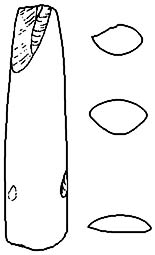
|
In Diagram 18.2 I have illustrated a Hane adze which differs from the 2A adzes and appears to resemble, in form and cross-section an adze illustrated by Suggs (1961, 108, Fig. 31 f) and designated by him as the Hatiheu Type. Although the "Hatiheu" type has been referred to as plano-convex by Sinoto (1968, 114) it appears that the above authors have assembled a number of quite similar forms, yet distinctively different types, in this group.* In the collection of illustrated Marquesan adzes by Figueroa and Sanchez (1965, Fig. 73, 74, 75) one finds both plano-convex and lenticular or sub-triangular (reversed) forms. A number of different theories could be presented to explain this diversity revolving around one form or type. It may be that the oldest form was a pecked oval base flattened, plano-convex type. Pecking appears to be present on the adzes from the lower layers (V and VI) at Hane, however the technique appears to have been abandoned. This transition to unpecked work would tend to produce more angular forms such as the lenticular and reversed triangular types. It is quite possible that the Marquesan artisans wished to retain the same basic characteristics as seen in the earlier types, long narrow blades, and curved cutting edges, however were less particular about the cross-section. Another theory might propose that the move towards a more triangular cross-section was inspired by discovery that the triangular base seated more securely in the haft. *(Note 04/05/2019) it has been decades since I wrote the above, and years since I have been working on archeological problems, however I want to mention here, that during the 2007 excavations at Atiahara, a complete finished adze was recovered, that is I suspect closely related to the MUH 1-R108-83 adze illustrated below (click here to see this adze). This adze was a surprise, untanged and possibly one the oldest adzes in the Tubuai collection. |

|
Certainly one of the biggest distinctions between the adzes of East and West is the greater presence of reversed triangular adzes in Eastern Polynesia. Helen Leach is of the opinion that true reversed triangular forms are not found in the West, and thus need to be invented or evolve in the East. A similar situation exists for the large quadrangular adzes, found only in the East. Helen adamantly asserts that quadrilateral flaking was never practiced in Western Polynesia. To answer my many questions about the Hane adzes, Helen would turn to her notes and illustrations made in the Bishop Museum, from these I gained the impression that plano-convex forms were present in the early levels along with the 2A forms. It strikes me that a parallel could be drawn between these and the Samoan adzes of the ceramic period as detailed by Green and Davidson. Of these it is said that there were but two common types, one was a thick plano-convex (Type Vb) and the other a flat trapezoidal (Type I). A similar situation may be found in the earliest Hane adzes however the flat trapezoidal adzes are reversed. The presence of pecking in the Marquesan adzes however clearly separates them from the Samoan (see Diagram 18.1a). It occurs to me that very little attention has been paid to the actual functional aspects of adzes, what were the most common tasks that they might be used for? The cutting of firewood seems an inevitable daily task, which adze performed this task? The adze required to quickly gouge out the hull of a canoe may not have been well adapted to the more common day to day tasks, similarly the adze used to fell large trees is not likely to have been used as often as other types. Certainly the making of a canoe required a full range of tools, however at any given moment certain adze forms (those most often used) must have been made more often. These must dominate in the general collection, being the most common. Thus I think it may be possible to isolate this adze for each period and discover evolutionary developements within it. In this regard pure statistical data may be very helpful, where one is mainly searching for common cutting edge form and weight. * Since writing the above I have had the good fortune to study another illustration of the Suggs adze in question, this rendering coming from the unpublished work of Mari Mari Kellum, her drawing clearly shows the adze as being plano-convex, the cross section of the Hatiheu example of Suggs is therefore drawn incorrectly. This is clearly shown by a comparison of this cross section with that of the Mouaka type (example e) shown on the same page and both adzes illustrated in the same view, that is, the back and left side, the cross section is oriented in the normal sence with the front of the adze at the top, the placement of the cutting edge has also been included within the cross section, As we now know the adze illustrated as example f Hatiheu type is in fact a plano convex form, the cross section cannot resemble as it does that of the Mouka type a reversed triangular form. Even a simple inversion of the cross section will not suffice for the included curved cutting edge must follow the convexity of the front (see a diagramatic correction of the Hatiheu adze). |